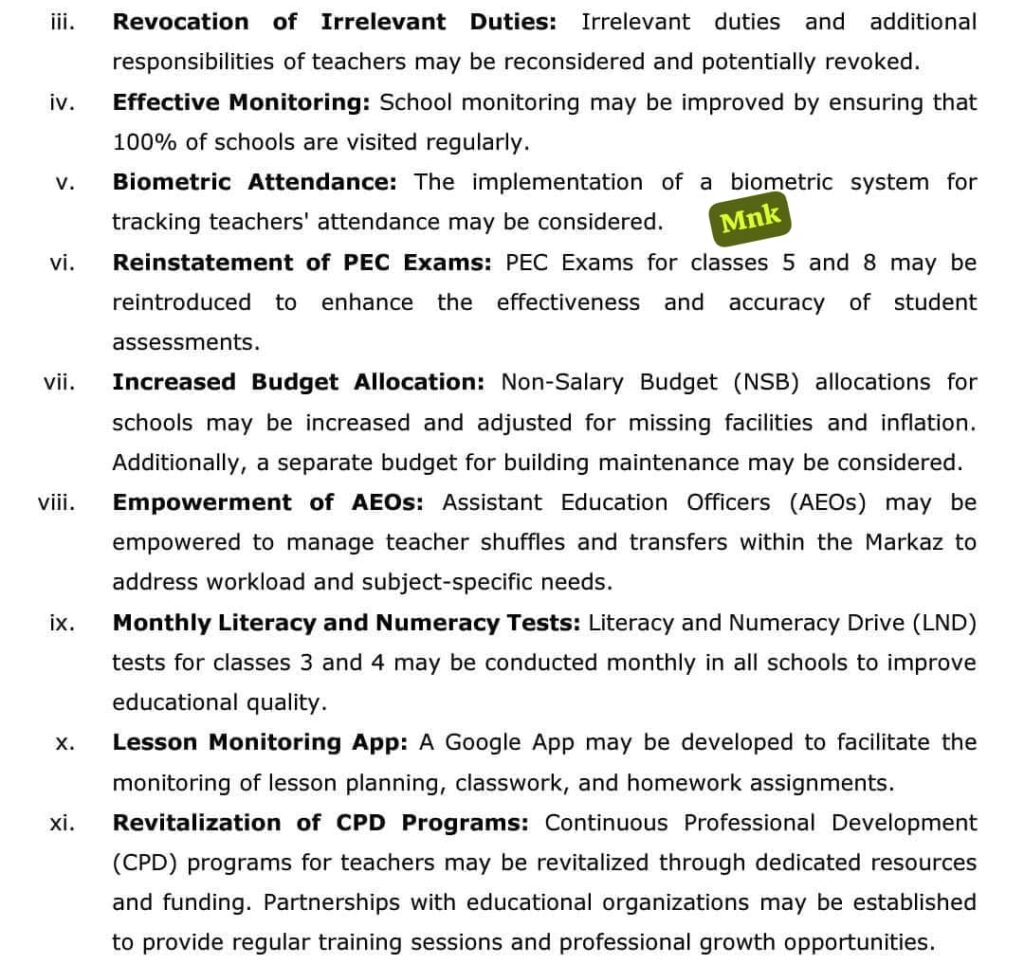Latest Educational News
Revamping Education in Pakistan: Proposed Reforms
Contents
- 1 Revamping Education in Pakistan: Proposed Reforms
- 1.1 Introduction
- 1.2 Proposed Reforms
- 1.2.1 1. Revocation of Irrelevant Duties
- 1.2.2 2. Effective Monitoring
- 1.2.3 3. Biometric Attendance
- 1.2.4 4. Reinstatement of PEC Exams
- 1.2.5 5. Increased Budget Allocation
- 1.2.6 6. Empowerment of AEOs
- 1.2.7 7. Monthly Literacy and Numeracy Tests
- 1.2.8 8. Lesson Monitoring App
- 1.2.9 9. Revitalization of CPD Programs
- 1.3 Table of Proposed Reforms
- 1.4 FAQs
- 1.5 Conclusion
Revamping Education in Pakistan: Proposed Reforms

Introduction
The education sector in Pakistan faces numerous challenges that hinder its progress. To address these issues and improve the quality of education, several reforms have been proposed. This article explores some of the key reforms that could significantly impact the education landscape in Pakistan.
Proposed Reforms
1. Revocation of Irrelevant Duties
- Rationale: Teachers often carry out administrative and non-teaching responsibilities that divert their attention from core teaching duties.
- Reform: Reconsider and potentially revoke irrelevant duties and additional koresponsibilities to allow teachers to focus on teaching and student development.
2. Effective Monitoring
- Rationale: Regular monitoring of schools is crucial to ensure quality education.
- Reform: Implement a system to ensure that 100% of schools are visited regularly to assess teaching practices, infrastructure, and student outcomes.
3. Biometric Attendance
- Rationale: Ensuring teacher attendance is essential for effective education delivery.
- Reform: Consider implementing a biometric system to track teacher attendance accurately and address absenteeism issues.
4. Reinstatement of PEC Exams
- Rationale: PEC exams provide a standardized assessment of student knowledge and skills.
- Reform: Reintroduce PEC exams for classes 5 and 8 to enhance the effectiveness and accuracy of student assessments.
5. Increased Budget Allocation
- Rationale: Adequate funding is necessary to improve educational facilities and resources.
- Reform: Increase non-salary budget (NSB) allocations for schools to address missing facilities and inflation. Consider a separate budget for building maintenance.
6. Empowerment of AEOs
- Rationale: AEOs play a crucial role in managing schools within their jurisdiction.
- Reform: Empower AEOs to manage teacher shuffles and transfers within the Markaz to address workload and subject-specific needs.
7. Monthly Literacy and Numeracy Tests
- Rationale: Regular assessments help identify and address learning gaps.
- Reform: Conduct monthly literacy and numeracy tests for classes 3 and 4 to improve educational quality.
8. Lesson Monitoring App
- Rationale: Technology can be used to support teaching and learning.
- Reform: Develop a Google app to facilitate the monitoring of lesson planning, classwork, and homework assignments.
9. Revitalization of CPD Programs
- Rationale: Continuous professional development is essential for teacher growth.
- Reform: Revitalize CPD programs for teachers through dedicated resources and funding. Establish partnerships with educational organizations to provide regular training sessions and professional growth opportunities.
Table of Proposed Reforms
| Reform | Rationale |
|---|---|
| Revocation of Irrelevant Duties | Focus teachers on core teaching responsibilities. |
| Effective Monitoring | Ensure quality education through regular school visits. |
| Biometric Attendance | Improve teacher attendance and accountability. |
| Reinstatement of PEC Exams | Enhance student assessment and accountability. |
| Increased Budget Allocation | Provide adequate funding for educational facilities and resources. |
| Empowerment of AEOs | Improve school management and address workload issues. |
| Monthly Literacy and Numeracy Tests | Identify and address learning gaps. |
| Lesson Monitoring App | Support teaching and learning through technology. |
| Revitalization of CPD Programs | Promote teacher professional development and growth. |
FAQs
- How will the revocation of irrelevant duties impact teacher workload?
- By reducing administrative and non-teaching responsibilities, teachers will be able to focus on their primary role of teaching, potentially reducing their workload.
- What measures will be taken to ensure the effectiveness of the biometric attendance system?
- The system should be implemented with appropriate safeguards to prevent fraud and ensure accuracy. Regular monitoring and maintenance will also be necessary.
- How will the increased budget allocation be utilized to improve educational facilities?
- The additional funding can be used to repair and maintain existing facilities, construct new classrooms, provide adequate equipment and supplies, and improve the overall learning environment.
- What role will AEOs play in the revitalization of CPD programs?
- AEOs can help identify the training needs of teachers within their jurisdiction, facilitate the organization of CPD sessions, and ensure that teachers participate in these programs.
Conclusion
The proposed reforms outlined in this article offer a comprehensive approach to addressing the challenges faced by the education sector in Pakistan. By implementing these reforms, the government can create a more conducive learning environment, improve educational outcomes, and equip students with the skills and knowledge necessary to succeed in the 21st century.








